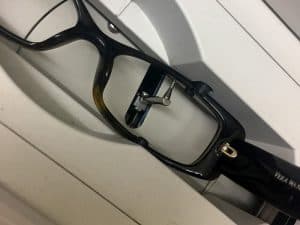Wearing glasses with the wrong prescription lenses can lead to various vision and health issues. While it might seem like a minor inconvenience, having the incorrect prescription in your glasses can significantly impact your eye health and daily comfort. This blog post explores the importance of correct prescription lenses, the risks associated with wearing the wrong lenses, and why it’s crucial to maintain an accurate prescription.
Understanding Prescription Glasses
How Prescription Glasses Work
Prescription glasses are designed to correct vision problems by compensating for the eye’s inability to focus light properly on the retina. This is achieved through lenses that are tailored to the individual’s specific vision needs. The prescription in your glasses is based on an eye exam conducted by an eye doctor, who determines the appropriate lens strength to address issues such as nearsightedness, farsightedness, astigmatism, or presbyopia.
Different Types of Prescription Lenses
- Single Vision Lenses: These lenses have one prescription strength throughout the entire lens, used to correct either nearsightedness or farsightedness.
- Bifocal Lenses: These lenses have two distinct areas for near and distance vision, typically with a visible line separating the two.
- Progressive Lenses: Also known as varifocal lenses, these offer a gradual transition between multiple prescriptions, providing clear vision at various distances without visible lines.
- Contact Lenses: Contact lenses offer the same corrective benefits as glasses but are worn directly on the eye. They come in various types, including daily, bi-weekly, and monthly disposables.
Importance of an Accurate Prescription for Vision Health
Having an accurate prescription is essential for maintaining good eye health. An eye exam is necessary to determine the correct prescription, ensuring that your glasses or contact lenses provide optimal vision correction. Incorrect prescription lenses can lead to various problems, including eye strain and discomfort.
Potential Risks of Wearing the Wrong Prescription Lenses
Eye Strain and Discomfort
Wearing glasses with the wrong prescription can lead to significant eye strain. When your eyes are forced to work harder to compensate for an incorrect prescription, it can cause fatigue and discomfort. Common symptoms include:
- Dry Eyes: Incorrect lenses can exacerbate dryness, leading to a feeling of grit or irritation.
- Blurry Vision: Misaligned lenses can cause your vision to be blurry, making it difficult to focus on objects clearly.
- Visual Distortion: Incorrect prescriptions can lead to visual distortions, such as double vision or difficulty with depth perception.
Increased Risk of Headaches and Migraines
Eye strain caused by wearing glasses with the wrong prescription can also result in headaches and migraines. When your eyes struggle to focus through incorrect lenses, it can create tension and discomfort that radiates to other parts of your head. This can result in:
- Tension Headaches: These are often caused by muscle strain around the eyes and forehead due to improper vision correction.
- Migraines: Frequent eye strain can trigger migraines, characterized by severe pain and sensitivity to light.
Impaired Vision and Potential for Worsening Eye Conditions
Using incorrect prescription lenses can impair your vision and may even lead to the worsening of underlying eye conditions. For example:
- Progressive Vision Loss: If your prescription glasses don’t provide the correct strength, it may accelerate the decline in your vision quality.
- Exacerbation of Existing Conditions: Conditions like astigmatism or presbyopia may become more pronounced if not properly managed with the right prescription.
Importance of Regular Eye Exams
To ensure that your prescription glasses or contact lenses are accurate and effective, regular eye exams are crucial. During an eye exam, an eye doctor will assess your vision and update your prescription if necessary. This helps prevent the risks associated with incorrect lenses and supports overall eye health.
Benefits of Regular Eye Exams
- Updated Prescription: Eye exams ensure that your prescription remains current, adapting to any changes in your vision over time.
- Early Detection of Eye Conditions: Regular exams can identify potential eye health issues before they become serious, allowing for timely treatment.
How to Maintain the Accuracy of Your Prescription
- Follow-Up Visits: Schedule follow-up eye exams as recommended by your eye doctor to ensure your prescription is still appropriate.
- Address Symptoms Early: If you experience discomfort or vision changes, consult your eye doctor promptly to adjust your prescription.
Common Symptoms of Incorrect Prescription Lenses
Wearing glasses with an incorrect prescription can lead to several uncomfortable symptoms. Recognizing these symptoms early can help you address the issue and maintain good eye health.
Blurry Vision and Difficulty Focusing
One of the most common signs that your prescription glasses might be incorrect is blurry vision. If you find that things are not as clear as they should be, it could indicate that your prescription is outdated or incorrect. Difficulty focusing on objects, whether near or far, can be frustrating and hinder your ability to perform daily tasks effectively.
Eye Fatigue and Dryness
Another symptom of incorrect prescription lenses is eye fatigue. Prolonged use of glasses that don’t have the correct prescription can strain your eyes, leading to discomfort and dryness. This is especially noticeable after extended periods of reading or working on a computer. Eye strain can be exacerbated by improper lens prescriptions, making it challenging to keep your eyes comfortable throughout the day.
Dizziness or Nausea
In some cases, incorrect prescription glasses can cause dizziness or nausea. This happens because your eyes are straining to adjust to lenses that don’t properly correct your vision. If you experience these symptoms, it’s important to seek professional advice from an eye doctor to determine if your glasses prescription needs adjustment.
How to Ensure Your Glasses Prescription Is Accurate
To maintain optimal vision and comfort, ensuring that your glasses prescription is accurate is crucial. Regular eye exams and effective communication with your optometrist are key components in achieving this goal.
Importance of Regular Eye Exams
Regular eye exams are essential for ensuring your prescription glasses are up-to-date and suitable for your current vision needs. Eye exams help detect changes in your vision and allow your eye doctor to provide an accurate prescription. It’s recommended to schedule an eye exam at least once every two years, or more frequently if you notice any changes in your vision.
During an eye exam, your optometrist will assess your vision and check for any signs of eye strain or other issues. They will determine whether your current prescription needs adjustment or if new contact lenses or prescription glasses are necessary. By keeping up with regular eye exams, you can ensure that your prescription remains accurate and effective.
Steps to Take if You Experience Issues with Your Current Prescription
- Schedule an Eye Exam: If you’re experiencing issues such as blurred vision or eye strain, promptly schedule an appointment with your eye doctor. Describe your symptoms in detail to help them understand your situation.
- Undergo a Comprehensive Eye Exam: During your appointment, your eye doctor will conduct a thorough eye exam to assess your current vision and determine if your prescription needs adjustment.
- Review Your Prescription: If your eye doctor finds that your prescription has changed, they will provide you with an updated prescription for glasses or contact lenses.
- Obtain New Eyewear: Follow your eye doctor’s recommendations and acquire new glasses or contact lenses based on your updated prescription. This will help alleviate discomfort and improve your vision.
- Monitor Your Vision: After obtaining new eyewear, keep track of your vision and comfort. If you continue to experience issues, schedule a follow-up appointment with your eye doctor to address any further concerns.
Tips for Communicating Effectively with Your Optometrist
Effective communication with your optometrist is key to ensuring your glasses prescription is accurate. When discussing your vision and any issues you’re experiencing, be specific about your symptoms. For example, if you’re experiencing eye strain while reading or difficulty focusing on distant objects, let your optometrist know. Providing detailed information will help them understand your needs and tailor your prescription accordingly.
Additionally, if you’re transitioning from wearing glasses to contact lenses or vice versa, make sure to mention this to your eye doctor. They can provide guidance on how to adjust to different types of eyewear and ensure that your prescription is suitable for your preferred option.
Conclusion
Maintaining accurate prescription glasses is crucial for clear vision and overall comfort. If you notice symptoms like blurry vision, eye fatigue, or dizziness, it’s important to address these issues promptly. Regular eye exams and open communication with your eye doctor will help ensure your prescription is always up-to-date.
For those experiencing discomfort or vision problems with their current glasses or contact lenses, consider Reglaze 4 U for a solution. Reglaze 4 U specializes in reglazing glasses with various lens options, including single vision, bifocal, and varifocal lenses. They offer high-quality, scratch-resistant lenses and excel in reglazing Oakley and wrap-style frames.
To get your prescription glasses back to optimal condition, contact Reglaze 4 U at 0116 367 6015 or email info@reglaze4u.com. They can provide you with the precise lenses needed to enhance your vision and comfort. Don’t wait for discomfort to escalate—take action today for clearer, more comfortable vision.





